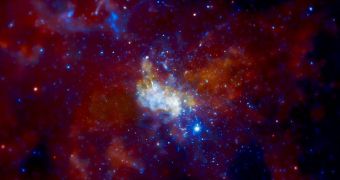The central region of our galaxy is most definitely inhabited by a black hole, says a team of researchers that analyzed the orbits of stars at the core of our galaxy, as they were spinning around its very center.
In-depth analysis of the stellar trajectories revealed that they must all be influenced by a single gravitational sources, which cannot be anything else other than a large black hole, fit to rule at the hear of the massive Milky Way.
Our galaxy is very large and very old. It has a diameter exceeding 100,000 light-years, and is estimated to be more than 10 billion years old. According to existing theories, this also implies that the black hole in its central area is also very large.
“The black hole came into existence billions of years ago, perhaps as very massive stars collapsed at the end of their life cycles and coalesced into a single, supermassive object,” explains University of California in Los Angeles (UCLA) professor of physics and astronomy Andrea Ghez.
The object is located an estimated 26,000 light-years away, or about 158 trillion miles away. For years, experts have been arguing that it exerts a huge attraction to objects in our galaxy, but the very existence of the object had not been thoroughly confirmed.
The black hole, long since known as Sagittarius A*, was determined in the new studies to be supermassive, as in several million times heavier than our Sun. This is why its gravitational pull on surrounding stars is so strong, and why it influences the motion of objects at the galactic core.
In the new investigations, it was revealed that some 20 stars in the region are traveling at blistering speeds, a lot faster than such massive objects usually do. Their speed was estimated to reach as much as 3 million miles per hour.
Only a black hole some 3 million times heavier than the Sun could cause stars to travel at 10 times their typical speed. Ghez conduced the new study using the 10-meter Keck I Telescope of the W.M. Keck Observatory atop Mauna Kea, in Hawaii.
Since the existence of Sagittarius A* was first inferred, a large number of telescopes, observing the Universe in a variety of wavelengths, attempted to catch a glimpse of the object. All of them failed.
Black holes attract everything in their surroundings. Their gravitational pull is so strong that they even trap photons, the elementary particles making up light. This means that no light gets reflected off them.
As such, they appear to be black, even though – past their event horizons – they are most likely very luminous from all the light they consumed, Daily Galaxy reports.

 14 DAY TRIAL //
14 DAY TRIAL //